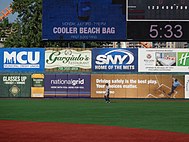
Back Patrocini esportiu Catalan Sportovní marketing Czech Sportmarketing German Patrocinio deportivo Spanish Sporditurundus Estonian Kirol babesle Basque بازاریابی ورزشی Persian Urheilumarkkinointi Finnish Marketing sportif French Sportmarketing Italian
| Marketing |
|---|
Sports marketing as a concept has established itself as a branch of marketing over the past few decades; however, a generally accepted definition does not exist.[1] Academicians Kaser and Oelkers (2005, p. 9) define sports marketing as 'using sports to market products'.[2] It is a specific application of marketing principles and processes to sport products and to the marketing of non- sports products through association with sport.[3]
Sports Marketing is a subdivision of marketing which focuses both on the promotion of sports events and teams as well as the promotion of other products and services through sporting events and sports teams focused on customer-fans.[4] It is a service in which the element promoted can be a physical product or a brand name. The goal is to provide the client with strategies to promote sports or to promote some other product, service, business or cause through sports. Sports marketing is also designed to meet the needs and wants of the consumers through exchange processes.[5] These strategies follow the traditional four "P"'s of general marketing: Product, Price, Promotion and Place. Another four "P"’s are added to sports marketing, relating to the fact sports are considered to be a service. The additional 4 P’s are: Planning, Packaging, Positioning and Perception. The addition of the four extra elements is called the "sports marketing mix."[6]
Sports marketing is an element of sports promotion which involves a wide variety of sectors of the sports industry, including broadcasting, advertising, social media, digital platforms, ticket sales, and community relations.[7] Sports marketing is divided into three sectors. The first is the advertising of sport and sports associations such as the Olympics, Spanish Football league, NFL and the IPL, as well as sport teams like Mumbai Indians, Chennai Super Kings, Real Madrid and the New York Yankees. The second concerns the use of sporting events, sporting teams and individual athletes to promote various products. The third category is the promotion of sports to the public in order to increase participation.
In the first case, the promotion is directly related to sports. In the second case, the products can but do not have to be directly related to sports. When the promotion is about sports in general, the use of this kind of strategy is called “Marketing of Sports”. When the promotion is not about the sports but sports events, athletes, teams or leagues are used to promote different products, the marketing strategy is denominated “Marketing through sports."[8] When the promotion is about increasing participation among the public, it is called "Grassroots Sports Marketing."[7] To promote the products or services, the companies and associations use different channels such as sponsorships of teams or athletes, television or radio advertisement during the different broadcast sports events and celebrations, and/or advertisement on sporting venues.
Street marketing of sports considers sports marketing through billboards on the street and also through urban elements (street lighters and sidewalks, etc.) to help promote and gain publicity during major worldwide sporting events such as the Football World Cup, the Olympic Games, the Cricket World Cup or the Super Bowl.[7]
- ^ Bühler, André; Nufer, Gerd; Rennhak, Carsten (1 January 2006). "The nature of sports marketing". Reutlinger Diskussionsbeiträge zu Marketing & Management (2006–06) – via ResearchGate.
- ^ Bühler, André; Nufer, Gerd; Rennhak, Carsten (2006). "The nature of sports marketing". Reutlinger Diskussionsbeiträge zu Marketing & Management (2006–06) – via EconStor.
- ^ Shank, Matthew D.; Lyberger, Mark R. (9 December 2014). Sports Marketing: A Strategic Perspective (5 ed.). London: Routledge. doi:10.4324/9781315794082. ISBN 978-1-315-79408-2.
- ^ Chirilă, Daniel; Chirilă, Mariana (26 May 2016). "THE NECESITY OF MARKETING IN INDIVIDUAL SPORTS OVERVIEW". Lucrări Științifice Management Agricol. 18 (2): 51. ISSN 2069-2307.
- ^ Lovelock, Christopher; Reynoso, Javier; D'Andrea, Guillermo; Huete, Luis (2004). Lovelock, Christopher; Reynoso, Javier; D'Andrea, Guillermo; et al. (eds.). Administración de Servicios [Service's Administration] (in Spanish). Pearson Educación Times. p. 760. ISBN 978-0-273-68826-6.
- ^ Beech, John; Chadwick, Simon (2006). Beech, John; Chadwick, Simon (eds.). The marketing of Sport. Prentice Hall and Financial Times. p. 592. ISBN 978-0-273-68826-6.
- ^ a b c Mullin, B. J., Hardy, S., & Sutton, W. (2014). Sport Marketing, 4th Edition. Human Kinetics.
{{cite book}}: CS1 maint: multiple names: authors list (link) - ^ Milne, G. R., & McDonald, M. A. (1999). Sport marketing: Managing the exchange process. Jones & Bartlett Learning.
{{cite book}}: CS1 maint: multiple names: authors list (link)



